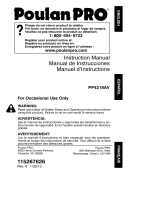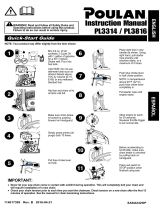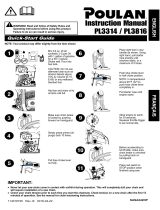
ELECTROLUX HOME PRODUCTS, INC.,
warrants to the origh_al purchaser that each
new Poulan _:brand gasoline ehah_ saw is
free from defects in material and workman-
ship and agrees to repair or replace under
this warranty any defective gasoline chain
saw as follows from the original date of pur-
chase.
1 YEAR - Parts and Labor, when used for
Household purposes.
60 DAYS - Parts and Labor, when used for
Commercial, Professional, or Income Pro-
ducing purposes.
30 DAYS - Parts and Labor, if used for rental
purposes.
This warranty is not transferable and does
not cover damage or liability caused by im-
proper handling, improper maintenance, or
the use of accessories and/or attachments
not specifically recommended by ELEC-
TROLUX HOME PRODUCTS, INC., for this
chain saw. Additionally, this warranty does
not cover damage caused by improper han-
dling, improper maintenance, or if the saw is
altered in any way which in our judgement af-
fects its condition or operation. This warranty
does not cover tune-up, spark plugs, filters,
starter ropes, starter springs, chain sharpen-
ing, bars, chains, and other parts which wear
and require replacement with reasonable
use during the warranty period. This warran-
ty does not cover predelivery set-up, instaF
lation of guide bar and chain, and normal ad-
justments explained in the instruction
manual such as carburetor adjustments and
chain tension adjustments. This warranty
does not cover transportation costs.
THIS WARRANTY GIVES YOU SPECIFIC
LEGAL RIGHTS, AND YOU MAY HAVE
OTHER RIGHTS WHICH VARY FROM
STATE TO STATE.
NO CLAIMS FOR CONSEQUENTIAL OR
OTHER DAMAGES WILL BE ALLOWED,
AND THERE ARE NO OTHER EXPRESS
WARRANTIES EXCEPT THOSE EX-
PRESSLY STIPULATED HEREIN.
SOME STATES DO NOT ALLOW LIMITA-
TIONS ON HOW LONG AN IMPLIEDWAR-
RANTY LASTS OR THE EXCLUSION OR
LIMITATIONS OF INCIDENTAL OR CON-
SEQUENTIAL DAMAGES, SO THE
ABOVE LIMITATIONS OR EXCLUSION
MAY NOT APPLY TO YOU.
The policy of ELECTROLUX HOME PRO-
DUCTS, INC., is to continuously improve its
products. Therefore, ELECTROLUX HOME
PRODUCTS, INC., reserves the right to
change, modify, or discontinue models, de-
signs, specifications, and accessories of all
products at any time without notice or obliga-
tion to any purchaser.
YOUR WARRANTY RIGHTS AND OBLIGA-
TIONS: The U.S. Environmental Protection
Agency, California Air Resources Board, Envi-
ronment Canada and ELECTROLUX HOME
PRODUCTS, INC., are pleased to explain the
emissions control system warranty on your
year 2005 and later small off-road engine. In
California, atl small off-road engines must be
designed, built, and equipped to meet the
State's stringent anti-smog standards. ELEC-
TROLUX HOME PRODUCTS, INC., must
warrant the emission control system on your
small off-road engine for the periods of time
listed below provided there has been no abuse,
neglect, or improper maintenance of your small
off-road engine. Your emission control system
includes parts such as the carburetor and the
ignition system. Where a warrantable condition
exists, ELECTROLUX HOME PRODUCTS,
INC., will repair your small off-roed engine en-
gine at no cost to you. Expenses covered un-
der warranty include diagnosis, parts and labor.
MANUFACTURER'S WARRANTY COVER-
AGE: if any emissions related part on your en-
gine (as listed under Emissions Control War-
ranty Parts List) is defective or a defect in the
materials or workmanship of the engine
causes the failure of such an emission related
part, the part will be repaired or replaced by
ELECTROLUX HOME PRODUCTS, INC.
OWNER'S WARRANTY RESPONSlBIU-
TIES: As the small off-roed engine engine
owner, you are responsible for the perfor-
mance of the required maintenance listed in
your instruction manual. ELECTROLUX
HOME PRODUCTS, INC., recommends that
you retain all receipts covering maintenance on
your small off-road engine, but ELECTROLUX
HOME PRODUCTS, INC., cannot deny war-
ranty solely for the lack of receipts or for your
failure to ensure the performance of all sched-
uled maintenance. As the smaII off-road en-
gine engine owner, you should be aware that
ELECTROLUX HOME PRODUCTS, INC.,
may deny you warranty coverage if your small
off-road engine engine or a part of it has failed
due to abuse, neglect, improper maintenance,
unapproved modifications, or the use of parts
not made or approved by the original equip-
ment manufacturer. You are responsible for
presenting your small off-road engine to an
ELECTROLUX HOME PRODUCTS, INC.,
authorized repair center as soon as a problem
exists. Warranty repairs should be completed
in a reasonable amount of time, not to exceed
30 days. If you have any questions regarding
your warranty rights and responsibilities, you
should contact your nearest authorized service
center or call ELECTROLUX HOME PROD-
UCTS, INC., at 1-800-554-6723.
18






















